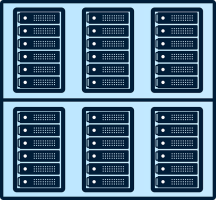A Virtual Private Server (VPS) is a type of hosting that allows a business or individual to host a website or application on a virtual machine that is isolated from other users on the same physical server. This type of hosting provides a number of benefits over traditional shared hosting, including increased performance and security, as well as the ability to customize the virtual environment to meet specific needs.
One key technology that enables VPS hosting is the use of hypervisors, also known as virtual machine monitors. A hypervisor is a software layer that sits between the physical hardware of a server and the virtual machines running on it, allowing multiple operating systems to run on the same hardware concurrently. This allows VPS hosting providers to create and sell multiple virtual servers on a single physical server, with each virtual server operating as if it were a separate, dedicated machine.
There are two main types of hypervisors: Type 1 and Type 2. Type 1 hypervisors, also known as bare-metal hypervisors, run directly on the host’s hardware, while Type 2 hypervisors, also known as hosted hypervisors, run on top of a host operating system.
Type 1 hypervisors are often used in enterprise environments, as they offer the highest level of performance and isolation. They are also the most complex to set up and manage, as they require direct access to the host’s hardware and do not rely on a host operating system. Examples of Type 1 hypervisors include VMware ESXi and Microsoft Hyper-V.
Type 2 hypervisors, on the other hand, are typically easier to set up and manage, as they run on top of a host operating system and do not require direct access to the host’s hardware. They are often used in smaller, less resource-intensive environments, such as personal laptops or home servers. Examples of Type 2 hypervisors include VMware Workstation and Oracle VirtualBox.
Regardless of the type of hypervisor being used, the process of creating and managing virtual servers on a physical host is generally the same. The hypervisor creates and manages virtual machines, which are essentially software simulations of physical servers. These virtual machines can be customized with specific operating systems, applications, and configurations, allowing users to tailor their virtual environment to meet their specific needs.
One of the major benefits of VPS hosting is the ability to customize the virtual environment. This can be particularly useful for businesses that have specific software or configuration requirements that cannot be met with a shared hosting environment. With VPS hosting, businesses can install and configure their own operating systems and applications, as well as set custom firewall rules and security protocols.
In addition to the ability to customize the virtual environment, VPS hosting also offers improved performance and security compared to shared hosting. With shared hosting, multiple websites or applications are hosted on the same physical server and operating system, which can lead to performance or security issues if one site is using a disproportionate amount of resources or is compromised. With VPS hosting, each virtual server is isolated from the others, so the performance & security of one virtual server is not impacted by the actions of others.
However, it is important to note that VPS hosting is not the right solution for every business. While it offers many benefits, it may not be suitable for those with very low traffic websites or those who are just starting out and do not have the resources to invest in a dedicated server. In these cases, shared hosting or a cloud hosting solution may be a better fit.
In conclusion, VPS hosting is a type of hosting that allows businesses and individuals to host websites or applications on a virtual machine that is isolated from other users on the same physical server. This type of hosting is made possible by the use of hypervisors, which are software layers that allow multiple operating systems to run on the same physical hardware concurrently.

